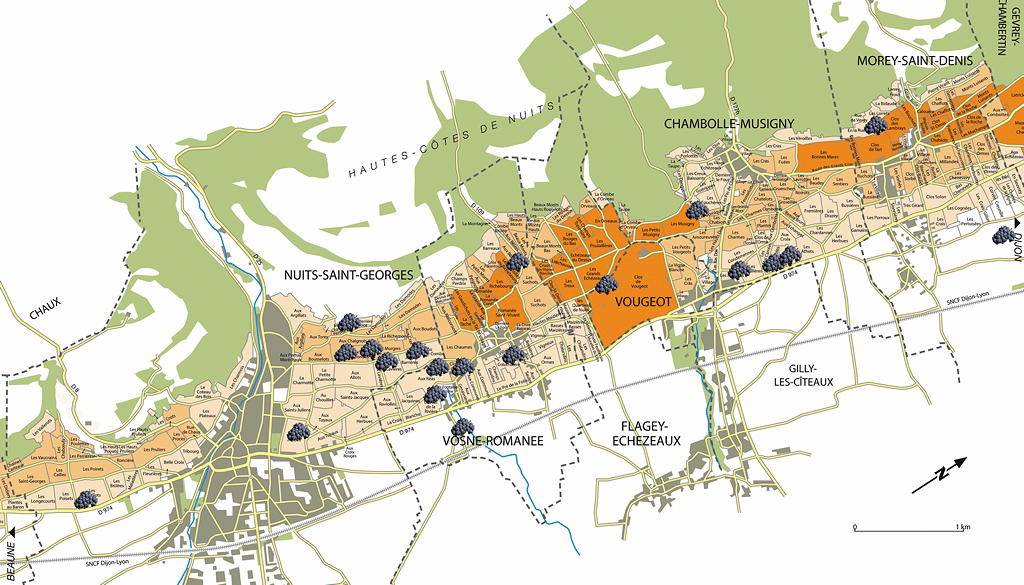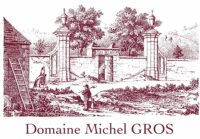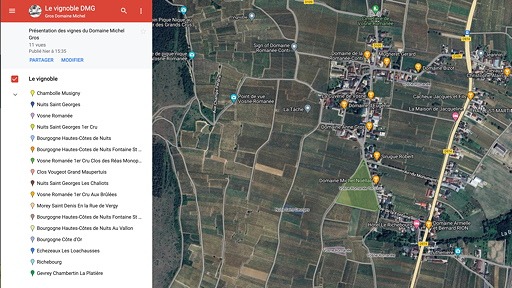Find all of our plots below
Click on the clusters to find out more about each of our appellations













Area : 0,80 ha
Age of the vines : 35-40 years old
Average annual production : 7 000 bottles
Grape Variety : Pinot Noir
Localisation :
It comes from two parcels in the village of Vosne Romanée, both of them situated at the bottom of the slope in the east of the national road 74. The soils are clay-silty above a subsoil of sand and pebbles of the Pleistocene era. These soils, poor in limestone, produce dark purple wines, with a strong acidity, i.e. very fresh and scented wines.

Area : 0,92 ha
Age of the Vines : 40 years
Average Annual Production : 6 000 bottles
Grape Variety: Pinot Noir
Localisation :
The grapes of three parcels compose this cuvee which originates from the localities: «Aux Reas », «Au- Dessus de la Riviere» and « La Colombiere ».
All of these parcels are located close to the village, the last two being located on conglomerates of clay limestone on Oligocene strata, which are called "Salmon conglomerates" because of their salmon-pink colour. As for « Les Reas », they lay on hard limestone soils on Bajocian strata. These marls which are alternated with limestone blocks produce very soft and elegant wines.

Area : 0,69 ha
Age of the vines : 50 years old
Average annual production: 5000 bottles
Grape variety : Pinot Noir
Localisation :
The main parcel (42 ares) is situated in the Argillières, the name of which gives a clue of the nature of the soil. This parcel continues the Musigny vines in the North at the entrance of the Chambolle comb. This parcel produces a cuvée with an unusual strength and density for a Chambolle village, and in this view it is rather similar to a Premier Cru.
Four other small parcels are situated in the following localities : Nazoires, Maladières and Mombies.
All these plots lie on the alluvial cone of the comb, their subsoil is therefore very stony, which ensures perfect drainage.

Area : 0,82 ha
Age of the vines : 35 years old
Average annual production : 5 000 bottles
Grape Variety : Pinot Noir
Localisation :
Four parcels contribute to the composition of this cuvée, all of them are located in the Northern part of Nuits Saint Georges, in the direction of Vosne, in the following "climats":
• Les ATHÉES : intensely dark red and deep soils situated on the alluvial deposits of the Meuzin valley;
• Les LAVIÈRES : a place where flat stones called "laves" can be found. Those stones were used in the past for roofing;
• Les BAS DE COMBE : this vineyard area is located just at the limit of Vosne Romanée, in the top part of the Réas valley;
• La PERRIÈRE-NOBLET : "perrière" means "quarry". It is located on a steep slope of hard limestone (White Oolite).
The assembling of these 4 parcels gives an elegant wine, with relatively supple tannins for this appellation. It stands as an "intermediary" between Vosne-type wines and Nuits-type wines.

Les Chaliots
Area : 0,82 ha
Age of the vines : 40 years old
Average annual production : 4 000 bottles
Grape variety : Pinot Noir
Localisation :
This name derives from the word "CHAILLE" which means small stones.
This "climat" in the southern part of Nuits is planted on an alluvial cone, which indicates a large presence of stones. The soil is clayey, poor in limestone and contains "chailles", a kind of reddish flint, rich in silica.
This very special type of soil has encouraged us to make a separate cuvée which characterizes by an abundant minerality, a very pure fruit expression, a quite strong acidity and a powerful body, which give it good aging qualities.


En la Rue de Vergy
Area : 0,23 ha
Age of the Vines : 20 years old
Average annual Production : 1500 bottles
Grape Variety : Pinot Noir
Localisation :
This very steep plot of land borders the southern wall of the famous "Clos des Lambrays", from which it is separated by the old "Route de Vergy", a very ancient road which joined Morey to the hillock of Vergy in a straight line.
In this place, the "Château des sires of Vergy" and "St Vivant abbey" were built. They were dominant powers in the region from the 12th-18th centuries.
This locality was completely regrouped and replanted in the 1980's. It is located on Comblanchien limestone covered by 30 to 35cm of a clayey and very stony soil. These soils, which are light and have a good filtering potential, give soft and very fine wines, very elegant.
A demand has been made for a 1er cru classification and is being studied by the INAO – French National Institute for AOC's and AOVDQ's.
Michel bought the vine when it was 3 year's old in 1995. The first vintage to be sold under this appellation is the 2000.

La Platière
Area: 0,33 ha
Age of the vines: 45 years old
Average annual production: 1500 bottles
Grape variety: Pinot Noir
Localisation :
This parcel called "La Platière" is located in the alluvial cone which is located downstream of the Lavaux valley, a mixture of silt and limestone alluvium carried over the millennia. This subsoil is present in a large majority of the village appellation Gevrey-Chambertin and gives wines that are both supple and deep, of high quality for simple “village” wines.

Area : 0,27 ha
Age of the vines : 35 years old
Average annual production : 1200 bottles
Grape variety : Pinot Noir
Localisation :
The crop of two localities composes this wine, which are situated in the northern part of Nuits-St-Georges and are quite close to each other. The VIGNERONDES and the MURGERS cover the lower third of the slope on a sandy soil with a good filtering potential. This wine is characterized by the strength of the Premiers Crus of Nuits- St-Georges, together with melted tannins which remembers its closeness to Vosne. It has excellent ageing qualities.

Aux Brûlées
Area : 0,63 ha
Age of the vines : 40 years old
Average annual production : 4 000 bottles
Grape variety : Pinot Noir
Localisation :
This parcel is located next to the GROS family parcel of RICHEBOURG in the north. The draining capacity of the place may explain its name: the natural vegetation would be quickly "burned" during summer because of the dryness of the soil. The soil is very stony on a 30 to 35cm thickness, and the subsoil is made of hard limestone (similar to Prémeaux stones). This wine offers a great minerality; it is similar to Richebourg from which it is separated only by a 3m-wide lane. But the soil, which is not as thick as the Richebourg's, brings more softness to the tannins and makes it more rapidly accessible.

Clos des Réas Monopole
Area : 2,12 ha
Age of the vines : 40 years old
Average annual production : 10 000 bottles
Grape variety : Pinot Noir
Localisation :
Alphonse GROS bought this “cru” in 1860 and we have the monopoly of this appellation. The engraving at the top of the label dates back to the buying of this parcel, since my ancestors had sold this wine in bottles right from the beginning. Generation after generation, the label has been bearing the following names :
• GROS-GUENAUD,
• GROS-RENAUDOT,
• Louis GROS,
• Jean GROS
• and from the 1996 vintage, Michel GROS.
The wall of this triangular parcel borders the village in the east. A monumental portal stands in its middle. A small and very ancient house marks the north angle, on the Town Hall square. The "Clos des Réas" is located on the hillock that overhangs the small Réas valley. The geological stratum of the subsoil is a "Salmon conglomerate" on the Oligocene strata, with, at this place, a large quantity of limestone blocks alternated with marls. This soil profile, together with the slope, ensures excellent drainage.The marls give wine the silky character of tannins, the elegance of perfumes and the slight acidity that make it easy to taste from its youngest age. However, this impression of easiness is misleading: thanks to the almost perfect balance of this wine, it can age 10 to 15 years while preserving its fruity expression and its freshness.

Grand Maupertuis
Area : 0,20 ha
Age of the vines : 25 years old
Average annual production : 1 000 bottles
Grape variety : Pinot Noir
Localisation :
This parcel is located in the "GRAND MAUPERTUIS" locality in the top part of the Clos, along the superior wall, bordering the "Grands Echezeaux". It was bought by Jean GROS in 1967 in the name of his son Michel, then aged 11. It borders the family parcel in the same locality, this parcel being presently trained by Anne GROS.
The 1985 frost imposed a complete pulling out of the vines. Re-planting was carried out in 1987 with the 115 clone on 161-49, which gave the grapes early ripening qualities.
This wine is characterized by very silky tannins and a quite poor acidity, which make it pleasant from its youngest age, even if it is very dense. However, it can easily be aged 10 to 15 years long.

Les Loachausses
Area : 0,37 ha
Grape Variety : Pinot Noir
Age of the vines : 30 years
Average annual production : 1 500 bottles
Localisation :
The parcel of Echezeaux is located in the climat “Les Loächausses” and extends over an area of 37 ares 60 centiares, or 0.376 hectare. It was acquired by Jules GROS, son of Louis-Gustave GROS and the third generation of the GROS family in Vosne Romanée, between 1910 and 1930. At the end of his life, Jules GROS had succeeded in bringing together the ensemble of parcels comprising the 2.5 hectares of lieu-dit “Les Loachausses”. Unlike neighbouring parcels, the rows of vines are planted on a north-south axis. The soil is deep there, with an important proportion of clays. Most of the parcel was replanted by the Domaine GROS Frère et Sœur in 1995.
Area : 0,41 ha
Grape Variety : Pinot Noir
Age of the vines : 30 years
Average annual production : 1 500 bottles
Localisation :
The parcel of Richebourg sits at the northern end of the climat, in the part designated the lieu-dit “Les Verroilles ou Richebourg” and its surface area is 41 ares 43 centiares, or 0.4143 ha. It was acquired by Louis-Gustave GROS in 1882. The purchase involved an area of around 2 hectares corresponding to what was denominated the “Clos des Verroilles”, a part of whose walls still survives to this day. This lieu-dit, originally distinct from the Richebourgs, was regularly sold as such at the end of the XIXth century. Thereafter, it was officially attached to Richebourg in 1924, before the creation of the AOC Richebourg in 1936.
















